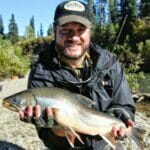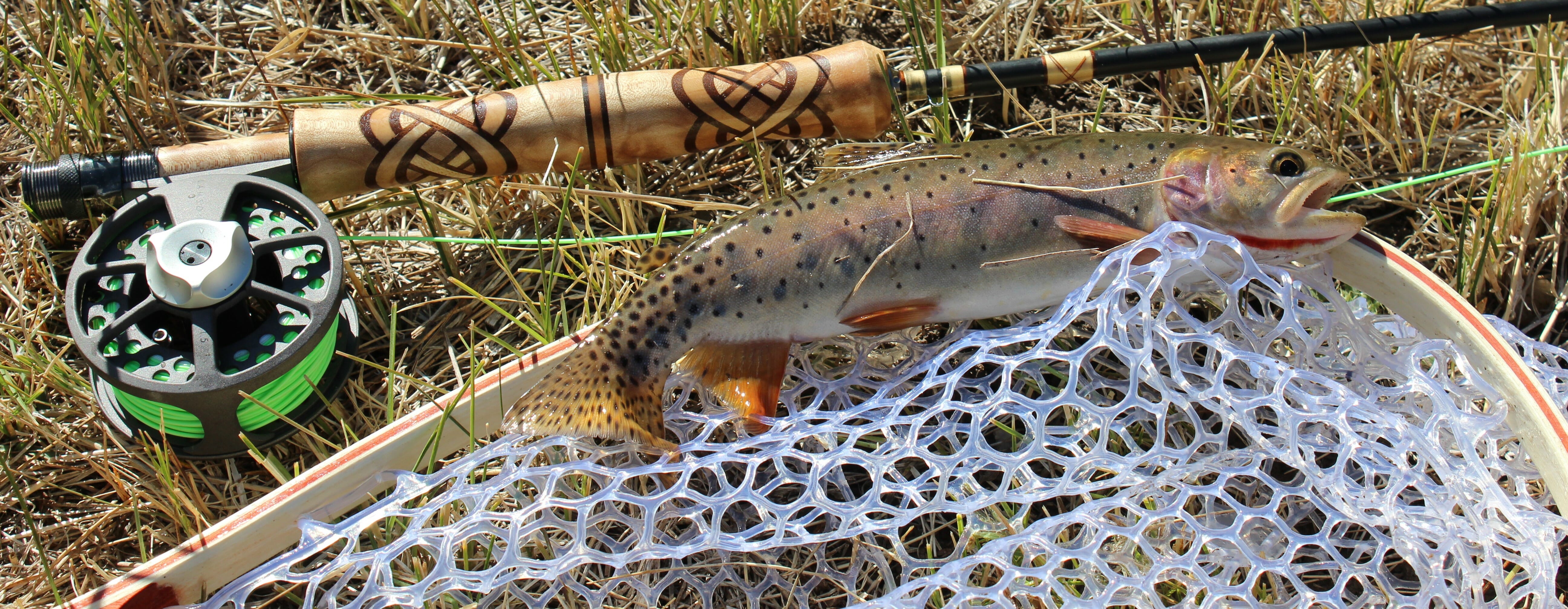By Travis Banta
It is safe to say we are a fishing family.
Grandpa Lee crossed the Madison River to his favorite fishing hole in an old 1940’s era Ford pickup. Grandma Margaret hated that bridge because it was essentially a couple of 2×12 boards and she didn’t like guiding the tires of that old Ford pickup across those narrows slats. They sold the farm in Montana and moved the family to Utah after the war, but still drove up to grandpa’s favorite fishing hole every year during the second week of June. Grandpa Lee died at his favorite fishing hole in 1958. My dad was 3-years-old when it happened. Dad jokes the only thing he learned from Grandpa Lee is the second week of June is the best time of the year to be at Grandpa’s fishing hole.
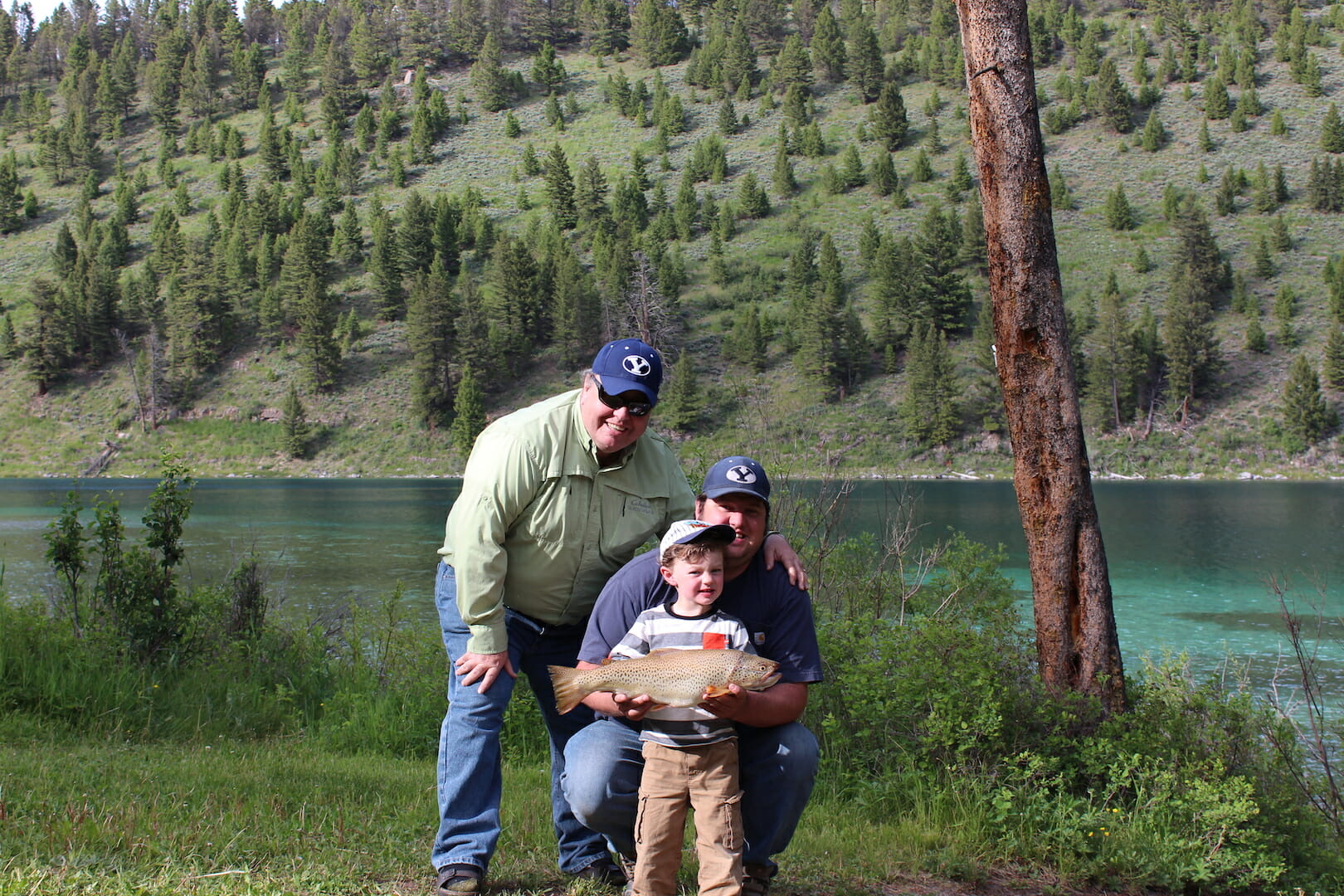
Bob, Travis and Lee Banta fishing at Grandpa’s Fishing Hole in Montana. Banta family photo.
I have always had a soft spot in my heart for cutthroat trout and when I heard about the Utah Cutthroat Slam, a partnership between Trout Unlimited and the Utah Division of Wildlife Resources, in April of 2016 I was determined to become a Cutt Slammer. Kokanee season picked up and I was distracted for a while, but every year kokanee season ends before I’m done fishing and I found myself focusing again on the Cutthroat Slam. I mentioned the slam to Dad, and although he is not quite the fisherman he once was, he wanted in on it as well.
Over the years, he’s added a weather prerequisite for going fishing: “sunny and 70,” he says. Lately, his weather prerequisite has been amended to “sunny and 70 with no wind.” I knew helping Dad do the slam would complicate matters because he can’t go where he used to or fish like he used to.
But, I figured, if I was going to help Dad do the slam I might as well help my son Lee, who was named for both his fishing great-grandfather Lee and my dad, his Grandpa Bob, become Utah’s youngest Cutt Slammer. On October 12, 2016, Lee finished the slam a month after he started – he was 3-years, 3 months old.
The Bear River Cutthroat:
We started the slam in September with a weekend trip to Bear Lake on the Utah/Idaho border. The weather was lousy with some moderate chop on the lake, falling far below Dad’s “sunny and 70” requirement, not to mention the more recent wind amendment. After about 10 AM, the weather laid down a touch and it was our chance to go. We motored south from the state park marina and set our downriggers. We found a few fish here and there on the fish finder, but it was tough keeping the lines in the water and keeping the boat straight. After about an hour, Lee jumped up and ran to a rod and yelled “blue rod, blue rod” according to our rod color scheme. He’s done that before because he has seen dad and grandpa do it many times. I explained to him that there was no fish on the downrigger. Lee insisted and started to cry because I wouldn’t let him reel in the blue rod.
For the sake of peace, I asked grandpa to take the wheel, got the rod out of the downrigger, snapped the blue rod out of the release, and handed it to him. Lee, mimicking us again, said “oh, this is a good fight Dad. This is a good fish.” A few seconds later, a small Bear River cutthroat popped up on Lee’s little Rapala and came to the net. He was nice enough to not rub it in that he was right and dad was wrong. We took a few pictures and released the fish back into the depths of the lake.
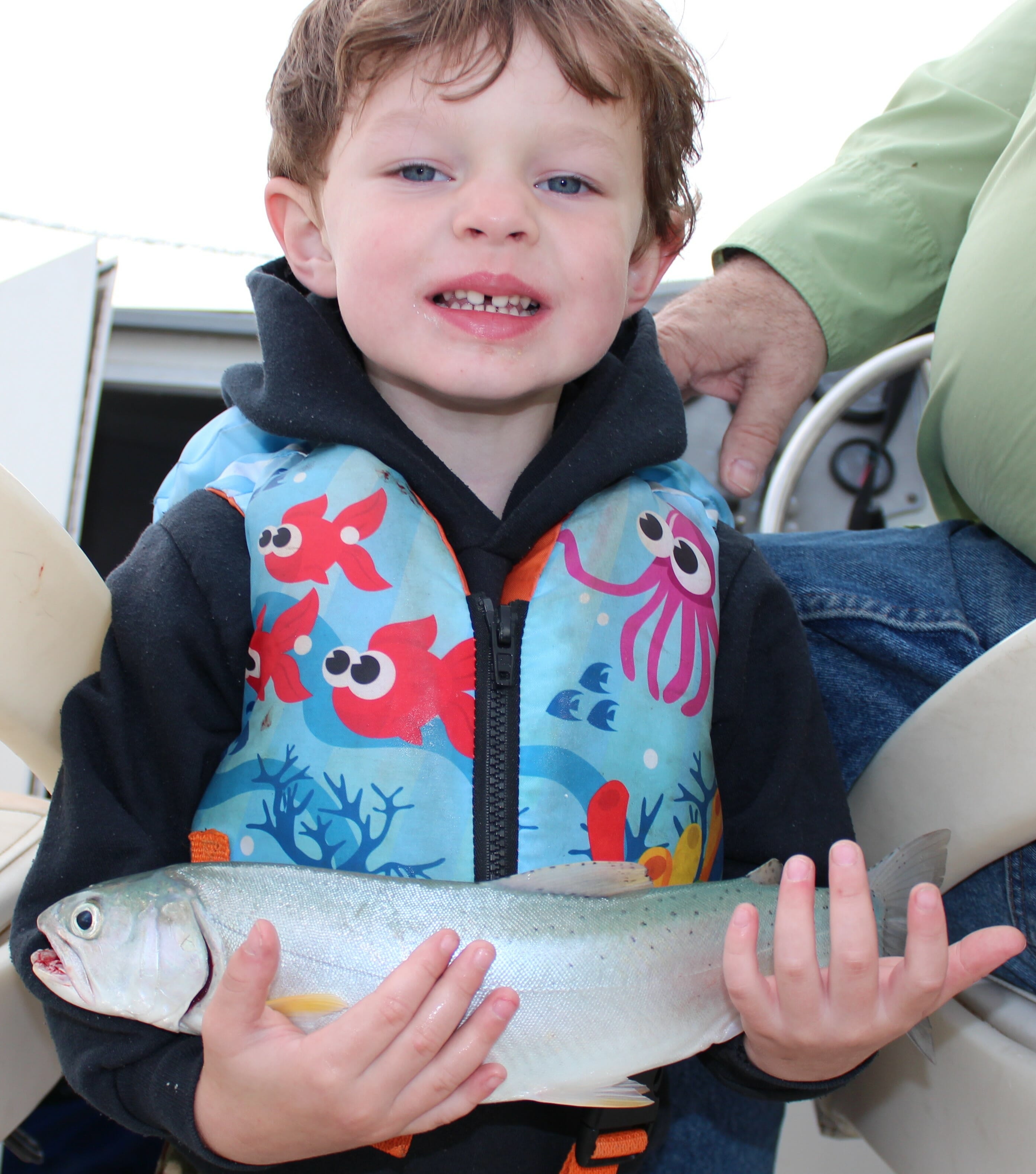
Three-year-old Lee Banta with a Bear River cutthroat caught at Bear Lake. The fish was the first landed in his effort to complete the Utah Cutthroat Slam. Banta family photo.
After a few high fives, grandpa got a nice cutthroat which was also released. I didn’t score until the next day in a storm just outside the marina.
The Yellowstone Cutthroat:
I was nervous about this getting this fish because it was a relatively long drive to a place I had never fly fished before and I needed to find three of these fish that were relatively close to the road. I poured over maps and spent quite some time on Google Earth looking at different options. I contacted the biologists from the Utah Division of Wildlife Resources to ask questions about where I should go. The information they gave me included descriptions of “small brushy streams” where “casting will be difficult or impossible in many places.” I did not feel better.
We arrived just after 5 p.m. on a Friday night. I was hoping that as soon as we crossed the bridge into the National Forest, we’d find a couple of accommodating cutthroat under the bridge that were ready to help a little boy get his Cutthroat Slam. No takers. We worked our way up and down the stream around the cows and down some steep embankments into a jungle like the ones I read about in Heart of Darkness back in high school. I quickly realized that this was not going to be our spot.
We got back in the truck and went to our backup plan. Night fell and we got lost on some backroads for a while. We were listening to Brigham Young University football on satellite radio so we were having a nice leisurely drive while we were looking for our backup spot. After we finally found the spot we were looking for, it was time for some dinner in the camper while we finished the football game. We went to sleep hoping that the next morning would find us three cutthroat richer.
I headed down the hill at first light while grandpa and Lee were still asleep. I fished the entire length of the stream probing any fishable looking pocket for several hours. At one point I found a pool that got me so excited I had to sit down for a few minutes to calm down. I dropped my caddis right at the base of the little waterfall, sure something would happen…. Nothing – Nothing – Nothing. I backed up and sat down again, frustrated that there wasn’t a single fish that moved in that pool in response to my caddis. As I sat, the sun got a little warmer and light got a little brighter, resetting my determination to find a fish. A grasshopper jumped on my fishing bag and I thought “maybe this is a sign”.
I tied on a hopper pattern and got back to work. One of my casts went slightly long and ended up on top of the waterfall, where a small trout turned on my hopper. He missed. He spooked, swam upstream, and buried himself in some weeds. I was crestfallen. I gave the fish some time and tried again and again and again and again. He wouldn’t participate. Frustrated, I moved farther upstream, hoping for another shot. The stream got smaller and smaller. I was following little trickles of water, maybe 6-8” wide, searching everywhere. Finally, I saw a tiny little hole in some foliage and heard a trickle of water that made me think there might be a little pool somewhere in that hole.
I buried the top end of my fly rod in the bush and let the hopper fall from my fingers into the hole. No sooner had it hit the water than I heard a splash and saw a small Yellowstone cutthroat flop out of the pool, firmly attached to the hopper. I snapped a fast picture and put him back in his pool, relieved I had finally found a fish after hours of poking through the creek.
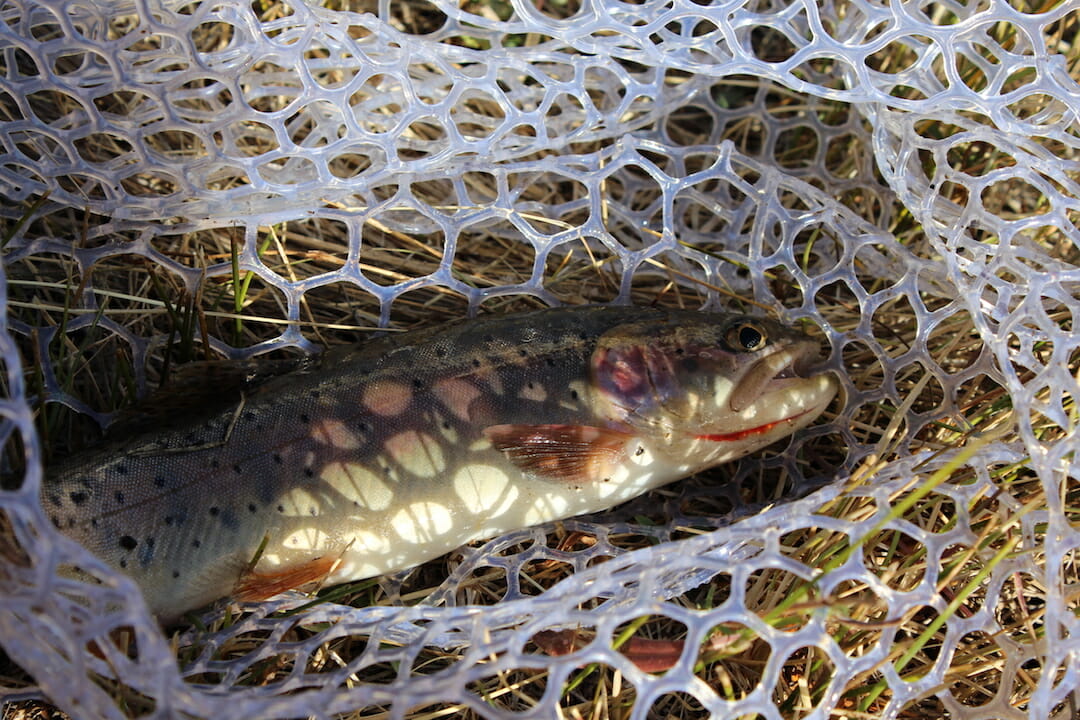
The Yellowstone cutthroat is typically the most difficult for anglers to catch when working on the Utah Cutthroat Slam. Banta family photo.
My relief dissipated quickly when I realized I had to find Lee and grandpa a fish too. I searched a little farther upstream for another likely spot, but the stream got smaller and smaller. As I walked through some dry grass to the last fishable bend in the creek I could see, I was inundated with grasshoppers. Thousands and thousands of grasshoppers jumped everywhere in front of me. The plague on Egypt was in full display as grasshoppers went everywhere. My last thought before charging back up the hill was “with all these grasshoppers, I bet that little cutthroat sees more than one hopper in a day.”
Grandpa and Lee were milling around the camper when I got back, and were prepared for bad news. I didn’t crack a smile until they could see it. “I found one. Let’s go.”
Lee headed down the hill with me. Just as before, I stuck my fly rod into the bush and had Lee hold the hopper in one hand. I guided his hand with mine on the handle of the rod. He let go of the hopper and it landed perfectly in the pool (a small miracle!). As soon as the hopper hit the water, the same greedy, I presume, cutthroat flopped out of his pool, hopper buried in the side of his lip.
I netted him quickly and took the hopper out. Lee was trying to move into position for a picture, but I told him no because this fish had already been stressed. I snapped a quick picture and put him back in his hole, grateful that this fish gave us a second chance.
Lee and I headed back up the hill with the great news for grandpa. He didn’t believe it until we showed him more pictures. He thought this fish might be the greediest fish in the river. “That’s how I like them, Dad.”
After breakfast, Lee and I convinced grandpa the fish would bite again if he would hike down the hill. As we arrived at the little hole, I explained the technique. A few seconds later, grandpa snapped a picture with the same cutthroat, I presume. Lightning struck three times. After a quick snap of the camera, the little cutthroat went back to his pool, but with the assurance that the next hopper that landed in his pool would be his to keep.
The hike up the hill was difficult for Grandpa and took a while. But, the relief and satisfaction made the hike pass quickly. We laughed at our hiking breaks about the odds of finding one greedy fish in a tiny hole in a miniscule creek in the middle of nowhere and getting him to hit the same hopper three times.
The Colorado River Cutthroat:
I have a favorite Colorado River cutthroat lake. It’s always treated me well in the past for both cutthroat and tiger trout that elicit the purest form of jealousy from fellow fishermen when pictures are flashed on my phone. We rented a bigger camper so we could take mom, little sister, dad, grandpa, and uncle. We arrived just before dark on a Friday night and we ended up listening to our Cougars win another football game on satellite radio.
First thing in the morning, Dad and Uncle were at our favorite spot with fish after fish cruising the shoreline looking for their next meal. After a few tries, I found the right nymph and the fishing was about as fast as it could be. Uncle’s gold spinner had much less frequent piscatorial interaction. After a few hours, we were joined by the rest of the adventurers and got grandpa into a fish pretty quickly on the nymph. Lee was feeling a little sick and wasn’t interested in fishing that morning. He and mom headed back to the camper for lunch and a snack before a little nap.
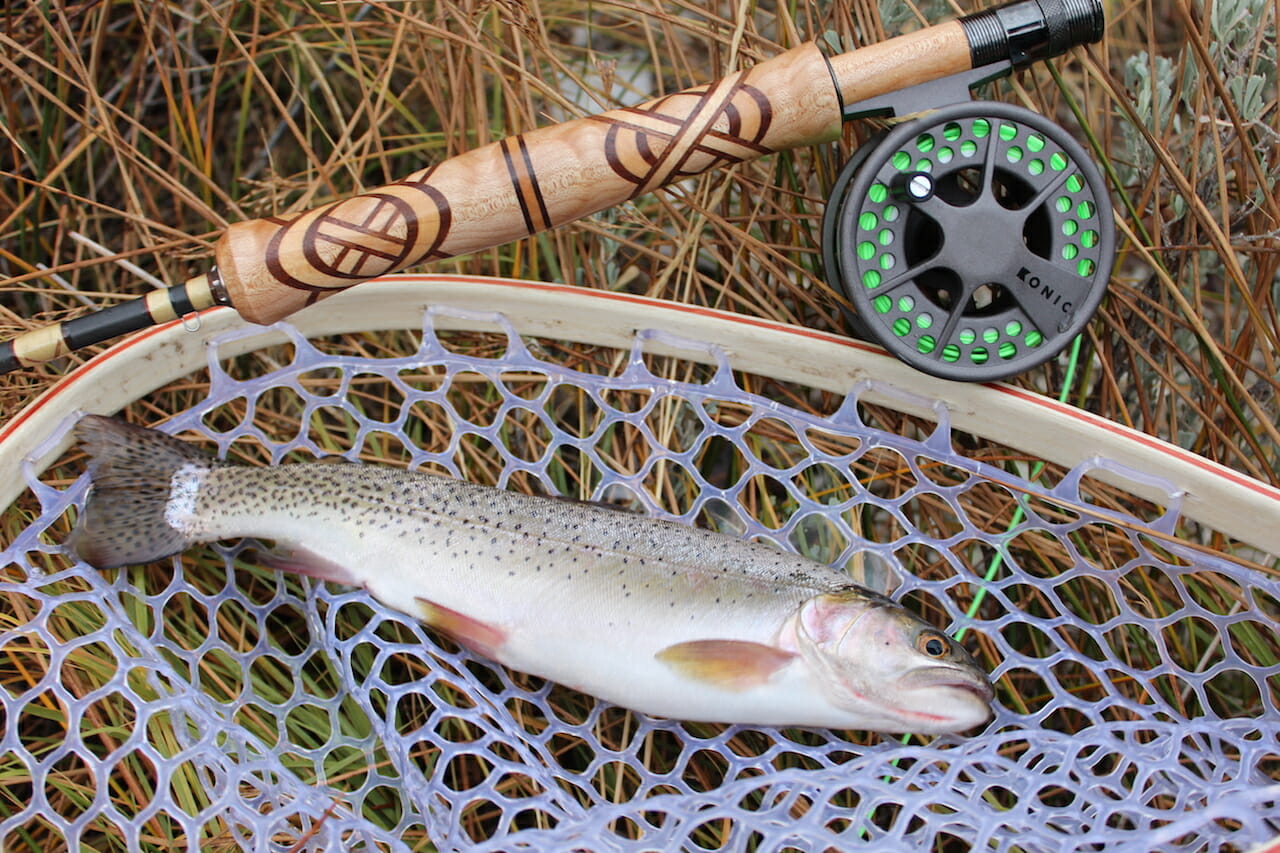
The fish Travis Banta caught to cross Colorado River cutthroat off his Utah Cutthroat Slam checklist. Banta family photo.
Later that evening, I took Lee on a little walk to our little spot. I showed him how to flip the nymph out. On a 9-foot rod, it didn’t take much to get the nymph 5- or 6-feet from shore where the cutthroat were cruising. Lee saw his indicator go under and pulled like dad told him, bringing a little tiger trout to shore. He was thrilled that his Cutt Slam was done and started to cry when I told him that this fish wasn’t a cutthroat and he needed to catch another one.
We sat down and looked at the fish in the net. I explained the difference between a char and a trout and asked him if this fish had the cutthroat mark on his throat. When pressed, he finally admitted that the tiger trout did not have the red slashes he was looking for and was willing to give it another try. He again flopped the indicator and less than a minute later the indicator went down again.
He yelled with excitement that this was going to be the fish. Sure enough, a cutthroat came to the net. We took the hook out and I handed the fish to him for his picture. The fish flopped. It was too much for a 3-year-old and “plop,” the final fish in his Slam was back in the water, with no picture. His little eyes welled up with tears again when I told him that fish wouldn’t count without a picture. After convincing him that he could catch another one, he tossed the nymph back in for a third time. He stuck his third fish in less than 10 minutes. As I netted the fish I heard a small reminder “don’t drop my fish, Daddy.”
He stuck his arms out to hold the fish like I showed him and told the fish to “stay still.” I snapped a few pictures and released the fish back into the lake.
The Bonneville Cuttroat:
We live very close to Millcreek Canyon close in Salt Lake City, so I thought Millcreek would be a quick and easy spot to get Lee and grandpa a fish. I went on a few scouting expeditions to find spots to take them where the fishing would be easy. While I was able to find one for me, I didn’t find anything that would make the job easy for Lee and grandpa.
So, Little Dell Reservoir would have to do. One night after work, Lee and I made the short commute to Little Dell and walked out to one of the points. From past experience, I knew what the cutthroat in Little Dell liked. Lee had a hard time casting far enough to have a real shot at catching a fish. So I would cast out for him and hand the rod to him to reel in, which also gave the Kastmaster a couple of extra seconds to sink. Lee would reel in as fast as he could, as much as I reminded him to slow down. After less than half an hour, I cast out and Lee started reeling in. I turned away, distracted by a moose walking in a nearby meadow, when I heard Lee say “Daddy, it’s really hard to reel in.” I looked at the tip of his rod and I said “Lee, you have a fish!” Lee kept reeling, slowed significantly by Mr. Bonneville hooked on to the gold Kastmaster. A minute later, Lee had cutthroat No. 4 in the net and ready for a picture.
After we released the fish Lee asked “Did I do it, daddy?” I told him he was officially a Utah Cutthroat Slammer. He put his clenched fists over his head as if he had just defeated Apollo Creed in the last round and shouted “Cutt Slam!” Lee caught several more fish that night using his same patented method of reeling like a crazy man and slowing down for a second when Dad told him to slow down. I couldn’t replicate the technique, but the cutts loved it.
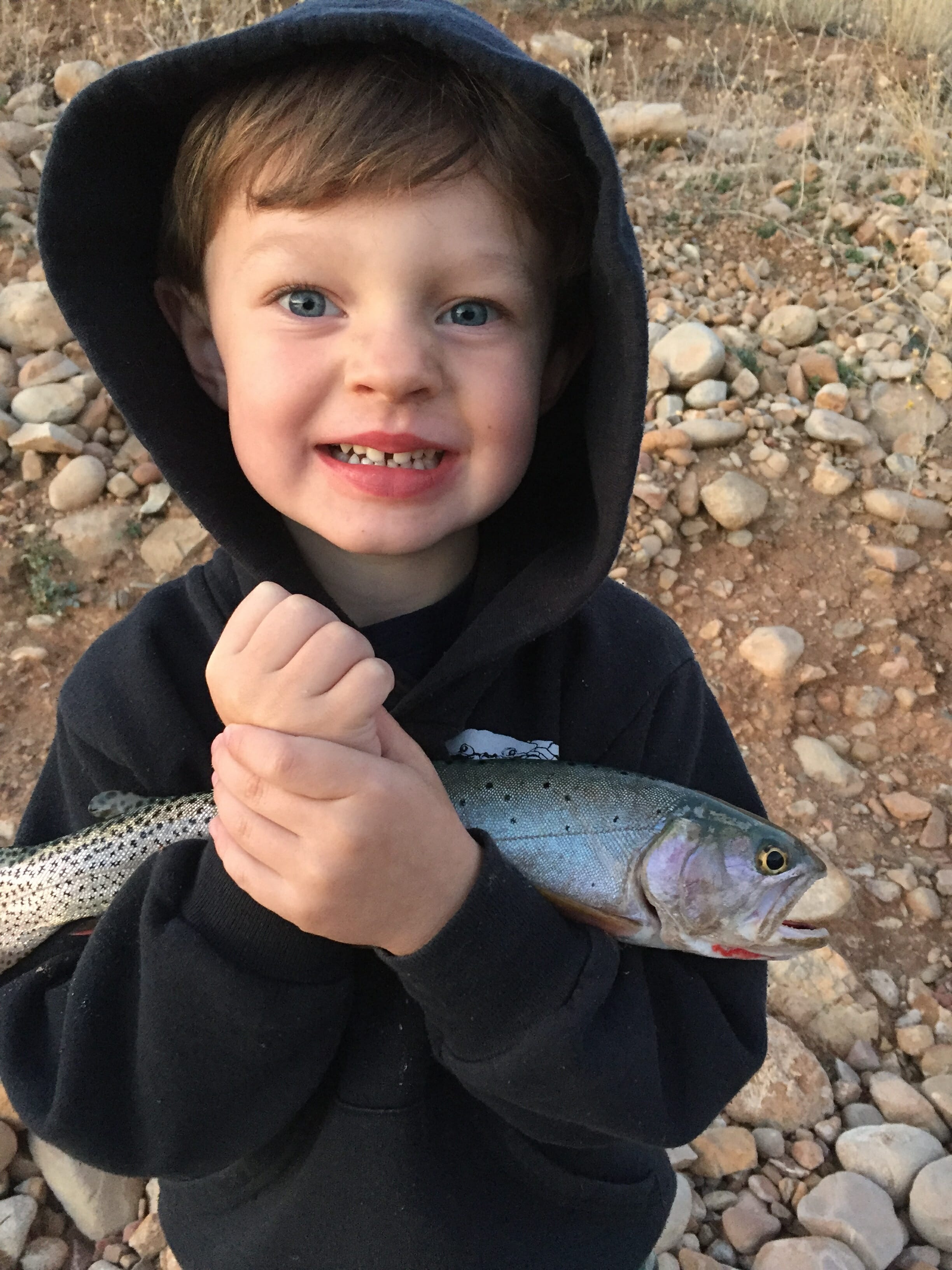
Lee Banta became the youngest to complete the Utah Cutthroat Slam when he caught this Bonneville cutthroat trout not far from his home in the Salt Lake Valley. Banta family photo.
On our way home, Lee insisted that we call Mom to tell her that he finished the slam. I put her on speakerphone so Lee could tell her that he caught the last cutthroat he needed for the slam. When we got home, mom and little sister were in the front yard to give him a hero’s welcome. Lee jumped out of the car and we exchanged high fives. He rode on my shoulders to an ice cream party in his honor as Utah’s youngest Cutt Slammer.
Reflecting on the Slam
The hardest part of the Cutthroat Slam for me was finding places that were accessible for grandpa and Lee. We had some real luck with the Yellowstone cutt that really made the whole slam possible for us. And, even then, it was a tough hike for Grandpa. It took a lot of planning and searching to find places where they could be successful. When we finally got our certificates framed, Lee wanted his hung in the front room so everyone who came to our house would see it. And, when anyone comes in now, Lee is the first to point to his certificate and tell them that he is a Utah Cutthroat Slammer.
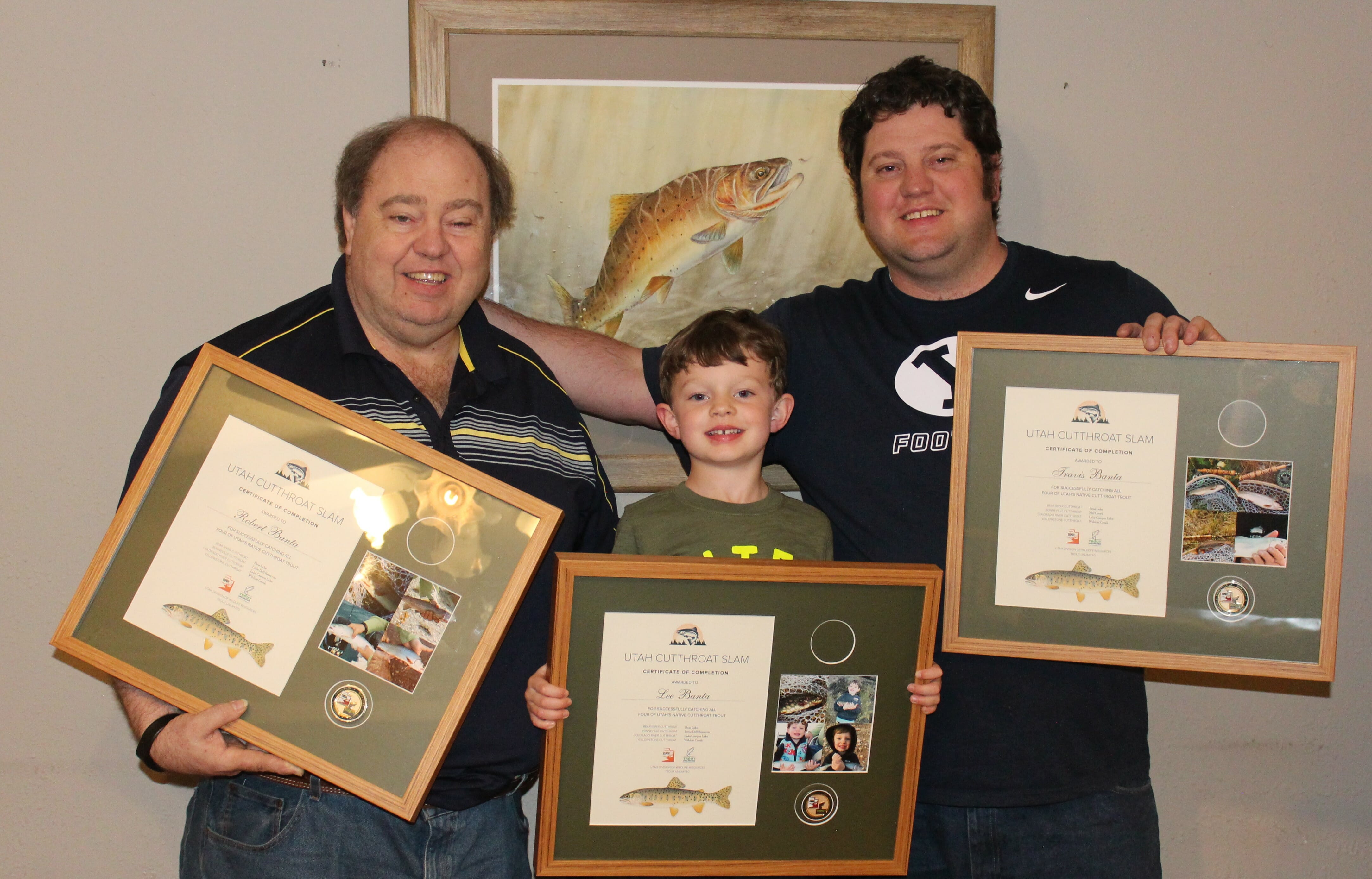
The Banta family, Bob, Lee and Travis, completed the Utah Cutthroat Slam together during the first year it was available. Lee, 3, became the youngest to complete the Slam. You can see the Banta’s have left an empty spot in their frames. They plan to do the slam again so they can get a second medallion to display both sides. Banta family photo.
We had so much fun last year that we left a spot in our frames for another medallion to do it all again this year. After the salmon turn red and the grasshoppers start swarming, we’ll be chasing cutthroat from big lakes to miniscule creeks and everywhere in between.
Travis Banta lives in Salt Lake City. He was the 114th angler to complete the Utah Cutthroat Slam in its first year of existence. He already has plans for completing a second Slam with his father and his son.


